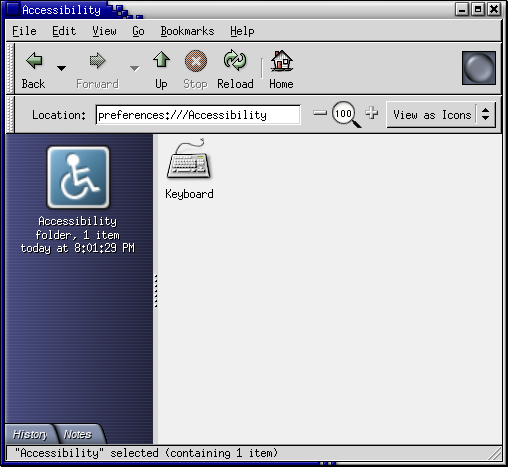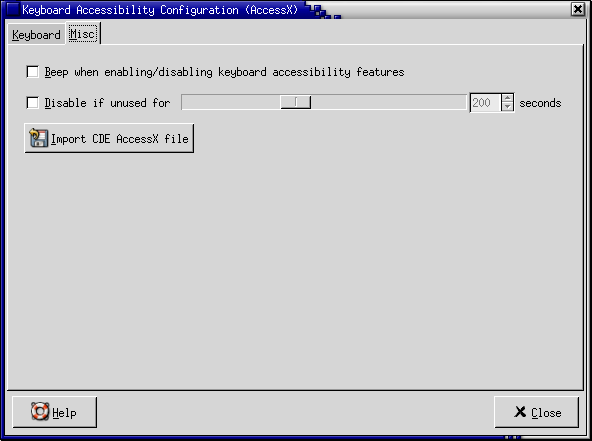Using the Accessibility Preference Tools
This chapter describes how to use the Accessibility preference tools to customize your desktop.
- II.11.1. Opening an Accessibility Tool
- II.11.2. Configuring Keyboard Accessibility Options
II.11.1. Opening an Accessibility Tool
You can open an Accessibility preference tool in the following ways:
-
From the menu
Choose . Choose the preference tool that you require from the submenu. The dialog for the tool is displayed.
-
From the Start Here location
Open a Nautilus window, then choose . Alternatively, double-click on the Start Here object on the desktop background. The Start Here location is displayed. Double-click on the Preferences object in the Nautilus window, then double-click on the Accessibility folder. The following figure shows the Accessibility folder:

II.11.2. Configuring Keyboard Accessibility Options
Use the Keyboard Accessibility preference tool to set the keyboard and miscellaneous accessibility preferences.
The Keyboard Accessibility preference tool is also known as AccessX.
You can customize the Keyboard Accessibility preference tool in the following tabbed sections:
- Keyboard
- Misc
- II.11.2.1. Keyboard Accessibility Options
- II.11.2.2. Miscellaneous Accessibility Options
II.11.2.1. Keyboard Accessibility Options
Table II.11-1 lists the settings that you can modify for the keyboard options.
| Option | Function |
|---|---|
| Enable keyboard accessibility | Select this option to activate the keyboard accessibility preferences. |
Enable Bounce Keys |
Select this option to accept a key input and to control the key repeat characteristics of the keyboard. You can specify the following bounce keys settings:
|
Enable Mouse Keys |
Select this option to make the numeric keypad on your keyboard emulate mouse actions. You can specify the following mouse key settings:
|
| Test Area | The test area is an interactive interface so you can see how the keyboard settings affect the display as you type. Type text in the test area to test the effect of your settings. |
Enable Slow Keys |
Select this option to control the period of time that you must press and hold a key before acceptance. You can specify the following slow keys settings:
|
Enable Sticky Keys |
Select this option to perform multiple simultaneous keypress operations by pressing the keys in sequence. You can specify the following sticky keys settings:
|
Toggle Keys |
Select this option for an audible indication of a toggle keypress. You hear one beep when a toggle key is turned on. You hear two beeps when a toggle key is turned off. |
You can use the Keyboard preference tool to configure the repeat key preferences. For more information, see Section II.9.4 ― Configuring Keyboard Settings.
II.11.2.2. Miscellaneous Accessibility Options
Use the Keyboard Accessibility preference tool to set your general accessibility preferences.
You can change some session-level accessibility options in the Misc tabbed section of the Keyboard Accessibility dialog.
Figure II.11-2 lists the settings that you can modify for the miscellaneous options.
| Option | Function |
|---|---|
| Beep when enabling/disabling keyboard accessibility features | Select this option for an audible indication when a feature such as sticky keys or slow keys is activated, or deactivated. |
| Disable if unused | Select this option to enable you to deactivate the keyboard accessibility preferences. Specify the period of time that must pass before timeout occurs. Setting range: 10 to 500 seconds. |
| Import CDE AccessX file | Click on this button to import a CDE AccessX configuration file. |

